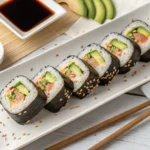Many people love pancakes for their fluffiness and comforting taste. A buckwheat pancake offers a wholesome twist on the usual stack. It’s naturally gluten free (if your buckwheat flour is labeled as such) and provides a nutty flavor that sets it apart from regular pancakes. Even though buckwheat isn’t actually wheat, it can mimic the texture of flour pancakes when combined with a few simple ingredients. In this pancake recipe, you’ll see how to use buckwheat flour to produce a satisfying plate of fluffy buckwheat pancakes.
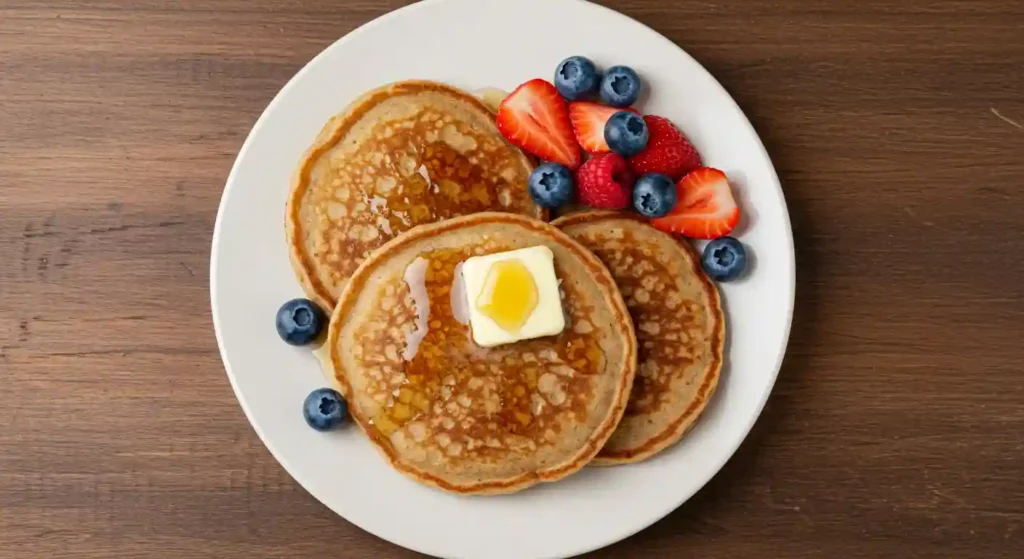
These delicious buckwheat pancakes cater to those trying buckwheat for the first time or those who went gluten free and want a new staple breakfast. They’re also perfect if you want to make buckwheat pancakes for a weekend treat. Let’s dive in and see why you might find these a better alternative to conventional flour blends.
Table of Contents
Why You’ll Love This Recipe
- Hearty Yet Fluffy
Despite the term “buckwheat,” these pancakes won’t be dense bricks. With the right approach, you get pancakes are light and airy, featuring a subtle buckwheat flavor. - Naturally Gluten Free
Many types of buckwheat flour are gluten-free, making these perfect for those who need or prefer gluten and grain free choices (verify your specific flour’s label). - Nutty Taste
A buckwheat pancake has a gentle, nutty flavor that pairs well with fruits, maple syrup, or savory toppings if you like sweet pancakes. - Simple Ingredients
You won’t need complicated items. Most steps just involve whisking dry ingredients and mix with liquid. This keeps the process quick and friendly for beginners. - Versatile
If you want fluffy buckwheat pancakes, you can easily tweak the batter by adding chocolate chips, bananas, or seeds for more excitement.
Ingredients
This recipe makes about 8 medium pancakes. You can double or halve it to suit your needs.
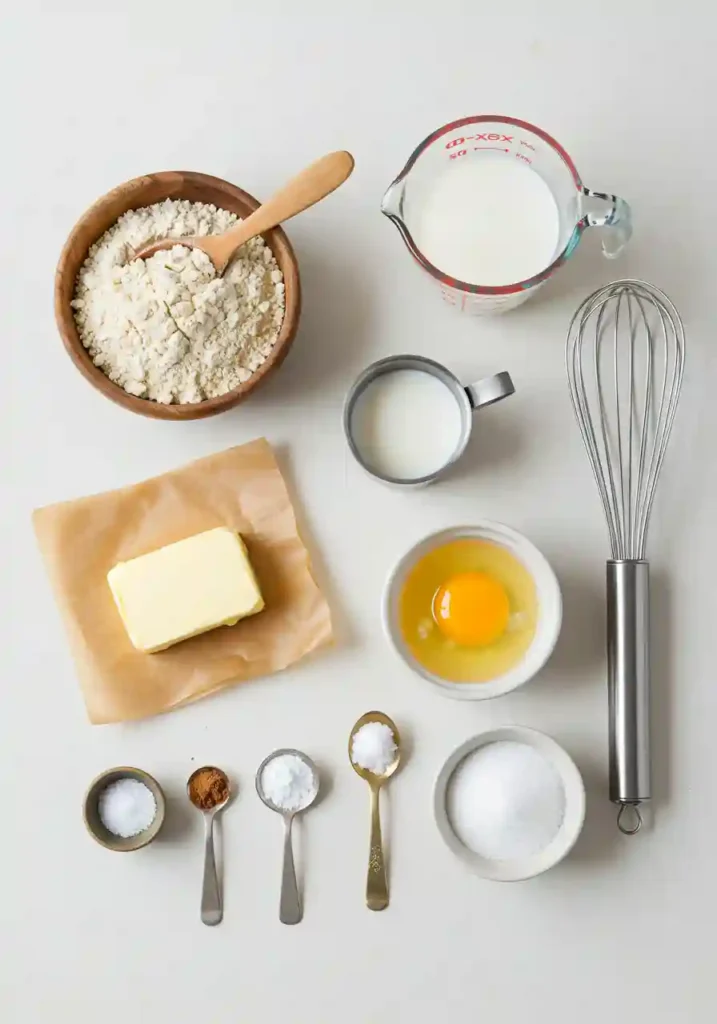
- 1 cup buckwheat flour (try a recognized brand like Bob’s Red Mill or any favorite buckwheat pancake mix)
- ¼ cup all-purpose flour (optional, helps create fluffier pancakes; skip for fully gluten-free)
- 2 tablespoons sugar (or sweetener of choice)
- 1 tablespoon baking powder (helps the pancakes fluffy)
- ¼ teaspoon salt
- 1 cup milk (dairy or non-dairy alternative; gluten free if needed)
- 1 large egg (omit or replace for vegan pancakes)
- 1 tablespoon melted butter or oil (extra for greasing pan)
- ½ teaspoon baking soda (optional, adds more lightness)
- (Optional) 1 teaspoon vanilla extract for extra flavor
If you prefer 100% buckwheat, skip the all-purpose flour. Or if you want them even richer, incorporate 1–2 tablespoons of melted butter into the batter for each pancake batch.
Instructions
Follow these steps to make pancakes that everyone can enjoy. The method is simple:
Step 1: Combine Dry Ingredients
- Mix is made
- In a bowl, whisk together the buckwheat flour (and the all-purpose flour if using), baking powder, baking soda, sugar, and salt. This blend of buckwheat ensures a uniform texture.
- In a bowl, whisk together the buckwheat flour (and the all-purpose flour if using), baking powder, baking soda, sugar, and salt. This blend of buckwheat ensures a uniform texture.
Step 2: Add Wet Ingredients
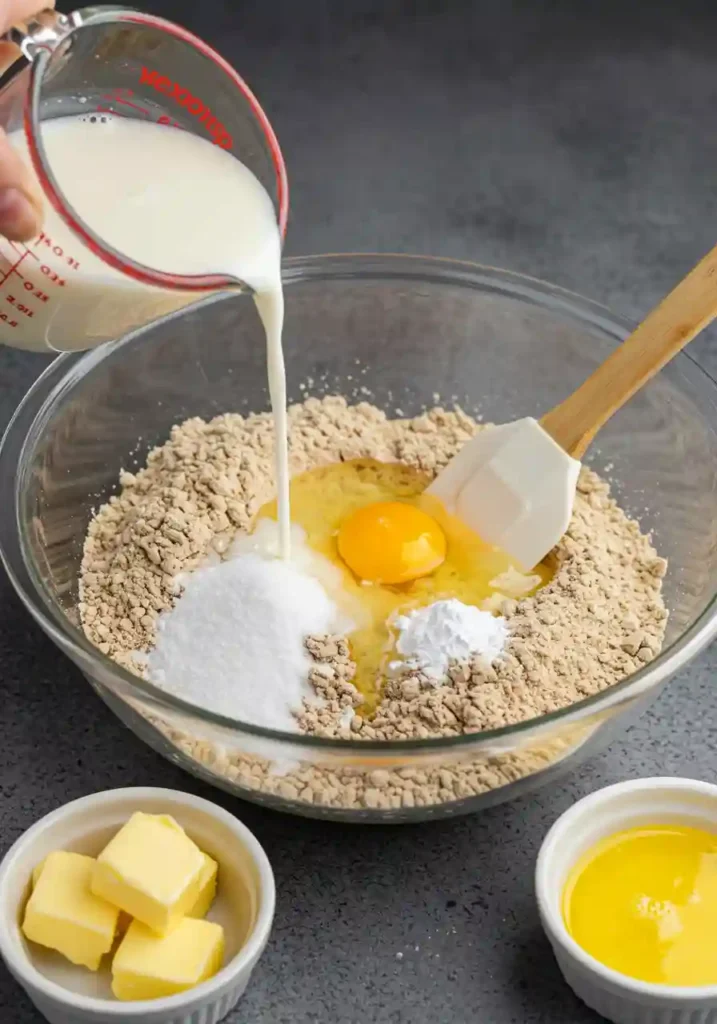
- Stir in Milk and Egg
- In the middle of the dry ingredients, make a small indentation, resembling a well. Crack the egg, add milk, and pour in melted butter (or oil). Stir gently.
- In the middle of the dry ingredients, make a small indentation, resembling a well. Crack the egg, add milk, and pour in melted butter (or oil). Stir gently.
- Avoid Overmixing
- Overbeating can make the pancakes tough. Mix the batter until it’s just combined; it should be slightly lumpy, not completely smooth. That helps produce fluffy results.
- Overbeating can make the pancakes tough. Mix the batter until it’s just combined; it should be slightly lumpy, not completely smooth. That helps produce fluffy results.
Step 3: Let the Batter Rest
- Brief Pause
- Set aside the pancake batter for about 5 minutes. This step thickens it and allows the buckwheat flavor to bloom.
- Set aside the pancake batter for about 5 minutes. This step thickens it and allows the buckwheat flavor to bloom.
- Check Consistency
- If the batter is too thick, add a small splash more milk to adjust the consistency. If it’s too thin, add a spoonful of buckwheat flour.
- If the batter is too thick, add a small splash more milk to adjust the consistency. If it’s too thin, add a spoonful of buckwheat flour.
Step 4: Cook the Pancakes
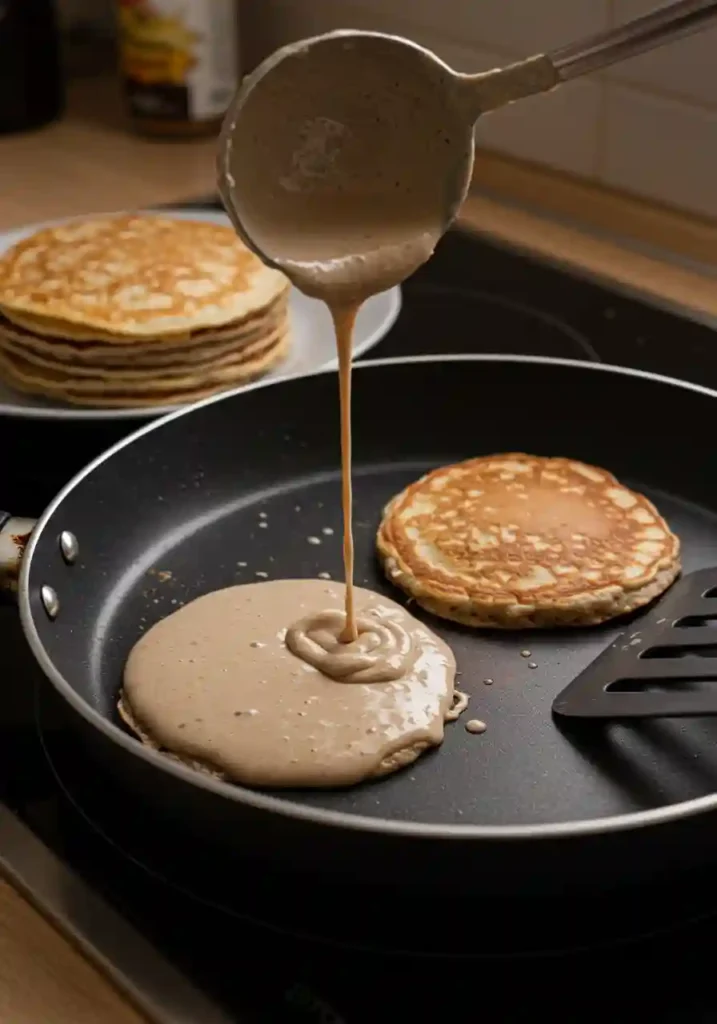
- Heat the Pan
- Warm a nonstick skillet or griddle on medium heat. Grease lightly with butter or oil.
- Warm a nonstick skillet or griddle on medium heat. Grease lightly with butter or oil.
- Portion the Batter
- Pour about ¼ cup of batter for each pancake. Spread gently if needed.
- Pour about ¼ cup of batter for each pancake. Spread gently if needed.
- Watch for Bubbles
- Cook the pancakes on the griddle until small bubbles begin to form on the surface, which should take about 2 minutes. Flip and cook the other side until golden. If your pancakes are browning too quickly before cooking through, lower the heat.
- Cook the pancakes on the griddle until small bubbles begin to form on the surface, which should take about 2 minutes. Flip and cook the other side until golden. If your pancakes are browning too quickly before cooking through, lower the heat.
Step 5: Repeat and Serve
- Stack ‘Em Up
- Transfer the pancakes to a plate and keep them warm as you finish the rest.
- Transfer the pancakes to a plate and keep them warm as you finish the rest.
- Enjoy
- Serve hot with maple syrup, fresh berries, or a dab of butter. This buckwheat pancake is also tasty with savory toppings like eggs or cheese.
- Serve hot with maple syrup, fresh berries, or a dab of butter. This buckwheat pancake is also tasty with savory toppings like eggs or cheese.
Pro Tips and Variations
- Gluten-Free Version
- Use only buckwheat flour (100%) if you want to ensure the recipe is completely gluten free. In this case, look for gluten-free buckwheat flour specifically labeled as such.
- Use only buckwheat flour (100%) if you want to ensure the recipe is completely gluten free. In this case, look for gluten-free buckwheat flour specifically labeled as such.
- Make Buckwheat Pancakes Vegan
- For an egg-free alternative, substitute the egg with a flax egg or chia egg. Use a non-dairy milk. These simple substitutions let you enjoy vegan pancakes with no fuss.
- For an egg-free alternative, substitute the egg with a flax egg or chia egg. Use a non-dairy milk. These simple substitutions let you enjoy vegan pancakes with no fuss.
- Add Protein
- For those wondering how to add protein to buckwheat, stir in a scoop of protein powder or mix mashed beans (like white beans) into the batter. Another trick is using Greek yogurt in place of some milk.
- For those wondering how to add protein to buckwheat, stir in a scoop of protein powder or mix mashed beans (like white beans) into the batter. Another trick is using Greek yogurt in place of some milk.
- Chocolate Chip Pancakes
- For kids or sweet-lovers, fold in chocolate chips. This yields a fun spin on your easy buckwheat pancakes.
- For kids or sweet-lovers, fold in chocolate chips. This yields a fun spin on your easy buckwheat pancakes.
- Create a Waffle Twist
- Turn this into a waffle recipe by cooking the same batter in a waffle maker. If you prefer buckwheat waffle outcomes, ensure your waffle mix is made with similar proportions.
- Turn this into a waffle recipe by cooking the same batter in a waffle maker. If you prefer buckwheat waffle outcomes, ensure your waffle mix is made with similar proportions.
Serving Suggestions
- Classic Maple
- Drizzle maple syrup on top. A swirl of whipped cream or peanut butter can also pair well with the taste of buckwheat.
- Drizzle maple syrup on top. A swirl of whipped cream or peanut butter can also pair well with the taste of buckwheat.
- Fresh Fruit
- Top with sliced bananas, berries, or peaches for a burst of color. These pancakes are one easy way to slip in fruit.
- Top with sliced bananas, berries, or peaches for a burst of color. These pancakes are one easy way to slip in fruit.
- Savory Style
- If you don’t like sweet pancakes, serve them with bacon, a fried egg, or cheese. The nutty flavor pairs nicely with salty toppings.
- If you don’t like sweet pancakes, serve them with bacon, a fried egg, or cheese. The nutty flavor pairs nicely with salty toppings.
- Extra Crunch
- Sprinkle toasted nuts or seeds for added texture if you want a heartier buckwheat pancake approach.
- Sprinkle toasted nuts or seeds for added texture if you want a heartier buckwheat pancake approach.
Conclusion
These pancakes made with buckwheat bring a new dimension to your breakfast or brunch routine. They’re light, full of buckwheat flavor, and can adapt to your dietary needs—whether you need gluten-free pancakes or want to tweak the ingredients to keep them vegan or protein-packed Similar to other pancakes. With minimal effort, you can whip up a batch for the entire family.
Take a moment to test how you like them best—drizzled with maple syrup, loaded with fruit, or kept simple. Once you’ve tasted their comforting nutty flavor, you might find yourself craving these over wheat pancakes. Make this recipe as is, or adapt it for your preferences. Let us know how it goes!
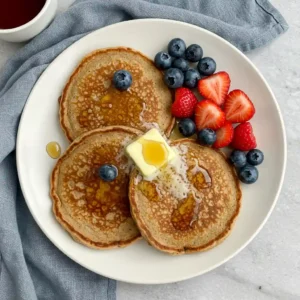
Buckwheat Pancake
Ingredients
1 cup buckwheat flour (try a recognized brand like Bob’s Red Mill or any favorite buckwheat pancake mix)
¼ cup all-purpose flour (optional, helps create fluffier pancakes; skip for fully gluten-free)
2 tablespoons sugar (or sweetener of choice)
1 tablespoon baking powder (helps the pancakes fluffy)
¼ teaspoon salt
1 cup milk (dairy or non-dairy alternative; gluten free if needed)
1 large egg (omit or replace for vegan pancakes)
1 tablespoon melted butter or oil (extra for greasing pan)
½ teaspoon baking soda (optional, adds more lightness)
(Optional) 1 teaspoon vanilla extract for extra flavor
Instructions
Step 1: Combine Dry Ingredients
- Mix is made
- In a bowl, whisk together the buckwheat flour (and the all-purpose flour if using), baking powder, baking soda, sugar, and salt. This blend of buckwheat ensures a uniform texture.
Step 2: Add Wet Ingredients
- Stir in Milk and Egg
- In the middle of the dry ingredients, make a small indentation, resembling a well. Crack the egg, add milk, and pour in melted butter (or oil). Stir gently.
- Avoid Overmixing
- Overbeating can make the pancakes tough. Mix the batter until it’s just combined; it should be slightly lumpy, not completely smooth. That helps produce fluffy results.
Step 3: Let the Batter Rest
- Brief Pause
- Set aside the pancake batter for about 5 minutes. This step thickens it and allows the buckwheat flavor to bloom.
- Check Consistency
- If the batter is too thick, add a small splash more milk to adjust the consistency. If it’s too thin, add a spoonful of buckwheat flour.
Step 4: Cook the Pancakes
- Heat the Pan
- Warm a nonstick skillet or griddle on medium heat. Grease lightly with butter or oil.
- Portion the Batter
- Pour about ¼ cup of batter for each pancake. Spread gently if needed.
- Watch for Bubbles
- Cook the pancakes on the griddle until small bubbles begin to form on the surface, which should take about 2 minutes. Flip and cook the other side until golden. If your pancakes are browning too quickly before cooking through, lower the heat.
Step 5: Repeat and Serve
- Stack ‘Em Up
- Transfer the pancakes to a plate and keep them warm as you finish the rest.
- Enjoy
- Serve hot with maple syrup, fresh berries, or a dab of butter. This buckwheat pancake is also tasty with savory toppings like eggs or cheese.
Notes
FAQs
Is buckwheat pancake mix good for you?
Yes. Many buckwheat pancake mix products are high in fiber, nutrients, and often naturally gluten free, so they can be a healthy option.
Why is buckwheat flour healthier?
Buckwheat flour contains more vitamins, minerals, and protein than some refined flours. It also offers a nutty flavor and can suit special diets like gluten-free if labeled properly.
What does a buckwheat pancake taste like?
It has a mild, earthy buckwheat flavor with slight sweetness. Some say it’s richer than regular pancakes.
Is buckwheat flour dark?
Yes. It can appear darker or grayish compared to white flour, especially if it’s a dark buckwheat flour. If you want a lighter tone, look for light buckwheat flour.
Is buckwheat healthier than wheat?
Buckwheat packs more protein and some unique antioxidants. It can be beneficial if you avoid gluten, but “healthier” depends on your dietary goals.
What is the difference between buckwheat pancakes and regular pancakes?
Buckwheat ones often have a nutty flavor, darker color, and potential for being gluten free. Standard pancakes use wheat flour and are typically lighter in color.
What is the healthiest flour to use for pancakes?
Many say whole grain buckwheat flour or spelt are good options due to their nutrient content. Yet it depends on personal needs—gluten-free flour blends or almond flour can also be healthy choices.
How to add protein to buckwheat?
You can add a scoop of protein powder, an extra egg, or even Greek yogurt. Some folks mix in cottage cheese or beans for a protein boost in the batter.

